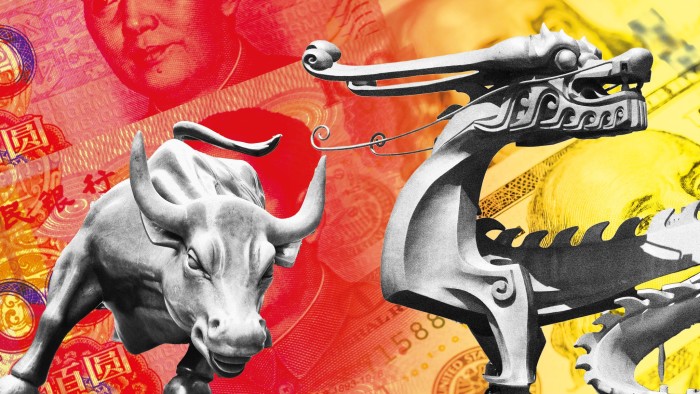S&P exceptionalism versus ‘expensiveism’


Roula Khalaf, Editor of the FT, selects her favourite stories in this weekly newsletter.
An old cartoon by Michael Leunig has a man crying out: “Here I am . . . unemployed, unimportant. And there you are . . . wealthy . . . powerful. You own property . . . gold . . . art . . . wine and human souls in massive, sickening, criminal quantities! How do you sleep at night?”
The other man replies: “I sleep at night between silk sheets on a heated, king size auto-massage waterbed with piped music in a very quiet street . . . with a companion whose beauty would make you weak with desire.”
I recall this cartoon whenever I hear the oft-asked question by analysts at the end of corporate earnings calls: “Great quarter, Bob, but I’d like to know what risks to your business keep you up at night?”
Having worked beside scores of chief executives and interrogated hundreds more, I can tell you they sleep like babies. As would you earning $17mn a year, the median paid to those atop S&P 500 companies, for example.
This is probably not fair to managers of many industrial firms, where safety is front of mind. And I know of airline bosses who constantly fear “that call”. But otherwise, give me a V-sweet C-suite job any time.
As if anyone would. Which is why I do lie awake worrying about my retirement portfolio — even on honeymoon last week (we have been married eight months already) — in particular my overweight position in Asian equities and my doughnut in American shares.
This is annoying because my other funds have been whispering lullabies in my ears over the past few months. Even my short-term US Treasury and energy funds are somniferous of late.
But let’s tackle the elephant in my bedroom first: zero Wall Street. The headline to my July 28 column last year was: “Help me doctor. I’m selling the US and buying Asia.” Having explained my rationale, many readers thought me mad.
Me too. When everyone was bearish on America at the beginning of 2023, I was its biggest fan. I bought an S&P 500 fund a few weeks later, selling again in September for a tidy 12 per cent profit.
I felt smug after share prices dropped almost a tenth over the subsequent two months. But my goodness what have they done since? Up another insomnia-inducing 13 per cent, that’s what.
Each day US equities hit new highs is like an upstairs neighbour tap-dancing in clogs. It doesn’t help that my Japan fund is up a respectable 10 per cent over the same period, nor does the 8 per cent from UK stocks dampen the noise.
What to do now? The problem I have is that two of my most deeply held investment beliefs are fighting it out in my head, as they are in markets. You can be as clever as you want but the medium term for US equities really only depends on which of them prevails.
The belief that drove my decision to sell is that valuation is everything. No matter how you cut and slice the index, whether you include megacap technology names or not, the S&P 500 is expensive relative to history. That rarely ends well.
We are told near the top of every bull market it is different this time, that company growth rates and margins and returns on equity will not fade. In the 1980s it was mandatory for western managers to fly to Japan to learn its secret sauce.
But the snag with rich valuations is that utopia is usually in the price. Many high-flying stocks in the dotcom era actually delivered insanely strong growth rates over subsequent decades. They crashed all the same because investors had discounted even madder projections.
The S&P 500 isn’t at such extremes today. But a trailing price/earnings ratio (which uses reported earnings in the denominator) is still about 23 times versus an average back a century of 18 times — suggesting prices are roughly a third too exuberant.
Unhedged, the FT’s markets newsletter, was also correct to point out this week that if you strip out the Magnificent Seven names — including the crazily expensive Amazon and Tesla — things don’t look any cheaper. The whole market is expensive.
Basic price-earning ratios have poor predictive power when it comes to future price returns anyway. Even metrics with better track records, such as cyclically adjusted PEs, or Q-ratios that focus instead on balance sheets, show the S&P to be hugely overvalued.
Such is where the first of my core beliefs leaves me. Trouble is my other one is that “you should never bet against America”. This is what a senior colleague told me on my first day as an equity fund manager almost 30 years ago. He has been right ever since.
You really have to live there to appreciate just how exceptional the US is when it comes to a desire to create wealth. It makes trillion-dollar companies for breakfast and creates yet more trillions before the rest of us have showered.
As with other technologies, US companies are again leading the way on everything from artificial intelligence and genetics to advanced chips and space. There is not a small chance that a boom in productivity lies ahead.
This could deliver the acceleration in growth needed to justify current valuations, as I have discussed before. So which is it then? For me, my belief in valuations just wins out. But I’ll be the first in line to buy US stocks again after a drop.
If they ever do. And should I ditch my perennially woeful Asian ETF to fund the purchase? Should I sell it anyway, I ponder in the wee small hours? Join me with coffee in the next column to discuss.
The author is a former portfolio manager. Email: stuart.kirk@ft.com; Twitter: @stuartkirk__
Comments